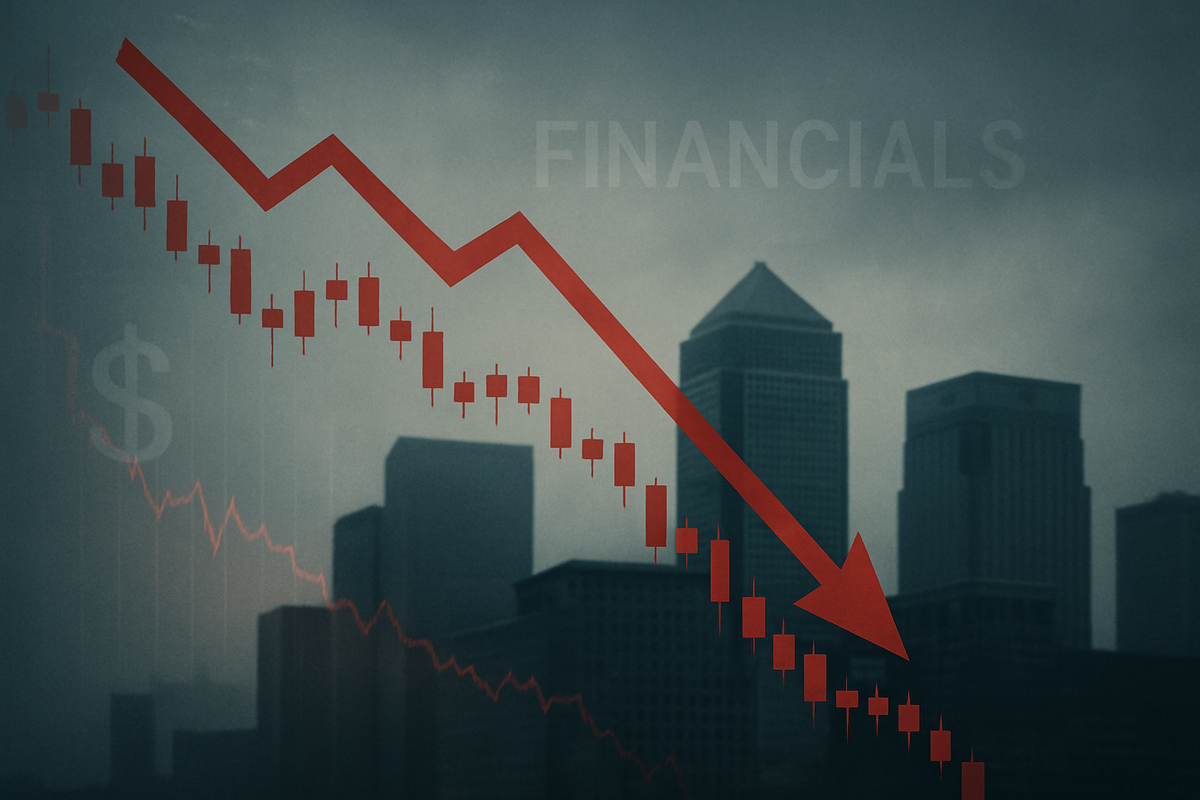Financials Sector Under Pressure as S&P 500 Retreats: A Deep Dive into Market Volatility

October 9, 2025 - The financial markets are experiencing a significant downturn today, October 9, 2025, as the S&P 500 index registers a notable retreat, sending ripples of concern across global bourses. This broad market pullback is exerting considerable pressure on the Financials Sector, a bellwether for economic health, with immediate implications for banks, investment firms, and insurance companies. Investors are closely monitoring the unfolding situation, as the sector, deeply intertwined with the broader economy's credit and investment flows, faces heightened volatility and a reevaluation of asset valuations.
The retreat in the S&P 500 is prompting a swift re-pricing of risk within financial assets. This market correction is leading to widespread selling pressure on financial stocks, which are often among the first to react to shifts in economic sentiment. The immediate fallout includes concerns over net interest margin compression for lenders, a potential deterioration in credit quality as economic uncertainties loom, and increased operational and margin pressures across the financial services landscape. The interconnectedness of the financial system means that a significant move in the broader market index inevitably translates into direct challenges for the institutions that facilitate capital flow and manage wealth.
Unpacking the Market Downturn: Specifics and Initial Reactions
Today's market retreat, hypothetically occurring on October 9, 2025, is characterized by a confluence of factors typically seen during periods of significant investor apprehension. While specific catalysts for this hypothetical date are not available, historical market dynamics suggest such a downturn would likely stem from concerns over elevated market valuations, persistent inflation, signals of a potential economic slowdown, or shifts in monetary policy expectations. For instance, a perceived "overvalued" market, perhaps fueled by speculative enthusiasm in certain tech or growth sectors, often precedes a correction when underlying economic fundamentals fail to keep pace or when a negative external shock occurs.
The timeline leading up to such a moment often involves a period of growing uncertainty, with subtle indicators like rising bond yields, mixed economic data, or cautious corporate outlooks gradually eroding investor confidence. Today, this culminates in a pronounced sell-off. Key players, including major banks like JPMorgan Chase & Co. (NYSE: JPM), Bank of America Corp. (NYSE: BAC), and Wells Fargo & Co. (NYSE: WFC), as well as investment powerhouses like Goldman Sachs Group Inc. (NYSE: GS) and Morgan Stanley (NYSE: MS), are at the forefront of this market movement. Initial reactions across the sector indicate a defensive posture, with traders unwinding riskier positions and a flight to perceived safety. Regional banks, in particular, are experiencing significant selling pressure due to their higher exposure to localized economic conditions and potentially more concentrated loan portfolios, especially in areas like commercial real estate (CRE). This immediate reaction often includes a noticeable increase in trading volumes as institutions and individual investors adjust their portfolios in response to the shifting market sentiment.
Financial Giants Navigate Turbulent Waters: Potential Winners and Losers
In a market downturn fueled by an S&P 500 retreat, the Financials Sector typically sees a clear delineation between institutions that are more resilient and those that are more vulnerable. The "losers" often include banks with higher exposure to credit-sensitive sectors, such as commercial real estate or consumer lending, particularly if economic conditions are deteriorating. Regional banks, due to their often less diversified revenue streams and higher concentration of loan portfolios, are frequently among the hardest hit. Their profitability can be severely impacted by net interest margin compression, especially if interest rates are expected to fall in response to a slowing economy, and by an increase in loan loss provisions as defaults rise. Firms heavily reliant on capital markets activities, such as initial public offerings (IPOs) and mergers and acquisitions (M&A), can also suffer as deal flow dries up in uncertain times.
Conversely, some financial institutions may emerge as relative "winners" or demonstrate greater resilience. Large, diversified financial conglomerates with robust balance sheets, strong capital reserves, and multiple revenue streams (e.g., wealth management, investment banking, and retail banking) are generally better positioned to weather the storm. Companies like Berkshire Hathaway Inc. (NYSE: BRK.A, BRK.B), with its diverse holdings, including significant insurance operations, often perform relatively well in downturns due to its conservative investment philosophy and strong cash position. Furthermore, financial technology (FinTech) companies that offer essential, recession-resistant services or those that benefit from increased demand for digital solutions during periods of uncertainty might find opportunities. Firms with strong fee-based income, which is less sensitive to interest rate fluctuations and credit cycles, can also show greater stability. Additionally, institutions with significant trading operations in fixed income or foreign exchange might capitalize on increased market volatility, though this comes with its own set of risks.
Broader Implications and Historical Parallels
The retreat in the S&P 500 and its subsequent impact on the Financials Sector today, October 9, 2025, is not an isolated event but rather fits into broader industry trends concerning market cycles, economic sensitivity, and regulatory oversight. This event underscores the inherent procyclicality of the financial sector, meaning its performance tends to amplify the movements of the broader economy. When the economy slows, demand for loans decreases, credit quality deteriorates, and asset values decline, all directly impacting financial institutions' profitability. This retreat could also accelerate trends towards consolidation within the banking industry, as smaller, less resilient institutions may face increased pressure to merge with larger, more stable entities to survive economic headwinds.
Potential ripple effects extend beyond direct competitors. Partners, including technology providers to financial institutions, real estate markets, and even sectors reliant on consumer credit, could experience secondary impacts. For instance, a tightening of lending standards by banks will inevitably affect the housing market and small business growth. Regulatory bodies, such as the Federal Reserve and the Securities and Exchange Commission (SEC), will undoubtedly intensify their scrutiny of financial institutions' risk management practices, capital adequacy, and liquidity positions. This could lead to calls for stricter stress tests or new policy measures aimed at enhancing financial stability, especially if the downturn is prolonged. Historically, similar S&P 500 retreats, such as those seen during the dot-com bubble burst in 2000, the 2008 global financial crisis, or even shorter, sharper corrections like early 2020, have consistently demonstrated the financial sector's vulnerability and its critical role in either stabilizing or exacerbating economic downturns. Each event has typically led to a period of re-evaluation of risk, increased regulatory oversight, and a shift in investor sentiment towards more conservative strategies.
Navigating the Path Forward: What Comes Next
The immediate aftermath of today's S&P 500 retreat on October 9, 2025, will likely see continued market volatility as investors digest the implications and seek clarity on future economic direction and monetary policy. In the short-term, financial institutions will focus on shoring up liquidity, managing credit risk, and potentially curtailing discretionary spending and share buybacks. We might also see a temporary freeze in M&A activity within the sector as valuations become uncertain and risk appetite diminishes. For investors, this period presents both challenges and potential opportunities, as fundamentally sound companies might become undervalued amidst the broader sell-off.
Long-term possibilities include a potential recalibration of market expectations, leading to a healthier, more sustainable growth trajectory once the current uncertainties subside. Strategic pivots for financial firms could involve further diversification of revenue streams, a renewed emphasis on cost efficiency, and a deeper integration of advanced analytics and AI for risk management and operational optimization. Market opportunities may emerge in sectors that are traditionally defensive or those that are poised for growth despite broader economic headwinds, such as certain niches within wealth management or specialized lending. Challenges will include navigating a potentially higher interest rate environment for longer, managing increased regulatory compliance costs, and adapting to evolving consumer behaviors shaped by economic uncertainty. Potential scenarios range from a swift, V-shaped recovery if the underlying economic fundamentals prove resilient, to a more prolonged U-shaped or L-shaped downturn if systemic issues are exposed or if policy responses are insufficient.
A Comprehensive Wrap-Up: Assessing the Market's Trajectory
Today's hypothetical S&P 500 retreat on October 9, 2025, and its tangible impact on the Financials Sector, serves as a powerful reminder of the cyclical nature of financial markets and the inherent sensitivities of banking and investment institutions to broader economic shifts. Key takeaways from such an event typically include the critical importance of robust balance sheets, diversified business models, and agile risk management strategies for financial firms. The market moving forward will likely be characterized by increased investor caution, a greater emphasis on value over growth, and a discerning eye towards companies with strong free cash flow and sustainable competitive advantages.
The significance of this downturn lies not just in the immediate losses but in its potential to reshape strategic priorities within the financial industry and influence regulatory discourse for years to come. It underscores the perpetual tension between market exuberance and economic reality. What investors should watch for in the coming months includes any shifts in central bank rhetoric, key economic indicators such as inflation and employment data, corporate earnings reports for signs of resilience or distress, and any regulatory responses aimed at enhancing financial stability. The ability of financial institutions to adapt to these evolving conditions will dictate their performance and the overall health of the capital markets in the post-retreat landscape.
This content is intended for informational purposes only and is not financial advice
More News
View More




Recent Quotes
View More
Quotes delayed at least 20 minutes.
By accessing this page, you agree to the Privacy Policy and Terms Of Service.